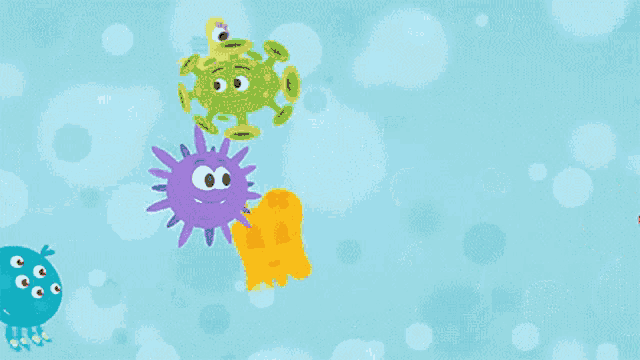
1) From Waste to Utility: Versatile Pipe Colorimeter for Agriculture, Health, and Environment
Ms. Unnati Kadu from the Department of Microbiology, Science College, Nagpur, has showcased exceptional academic and research excellence through her achievements in the 17th Avishkar Research Convention 2024–25. In Round 1, held at Binzani City College, Nagpur, she secured a Silver Medal in the Agriculture and Animal Husbandry category for her innovative project titled “From Waste to Utility: Versatile Pipe Colorimeter for Agriculture, Health, and Environment.” Her work, guided by Dr. Sarang Dhote, was commended for its scientific relevance and practical applications in addressing real-world challenges through microbiological solutions. The project involves a low-cost, eco-friendly colorimeter built from waste electric pipes, offering sustainable and accessible diagnostics for agriculture, health, and environmental monitoring. Capable of detecting pesticide residues in crops, hemoglobin in blood, milk quality, and heavy metals in water, the device serves multiple sectors efficiently. Ms. Unnati Kadu further secured 3rd position at the university-level Avishkar 2024–25 competition at G.H. Raisoni College, representing RTM Nagpur University across districts including Nagpur, Wardha, Bhandara, and Gondia. Her success earned her qualification for the state-level Avishkar in Raigad. Notably, the device’s design allows for AI integration, enabling real-time analysis, pattern recognition, and data-driven decision-making. This innovation empowers small-scale farmers, rural health centers, and educational institutions by offering affordable, portable, and smart solutions. Her contribution reflects the impact of student-led research, strong mentorship, and sustainable innovation in transforming critical sectors and inspiring future scientific progress.
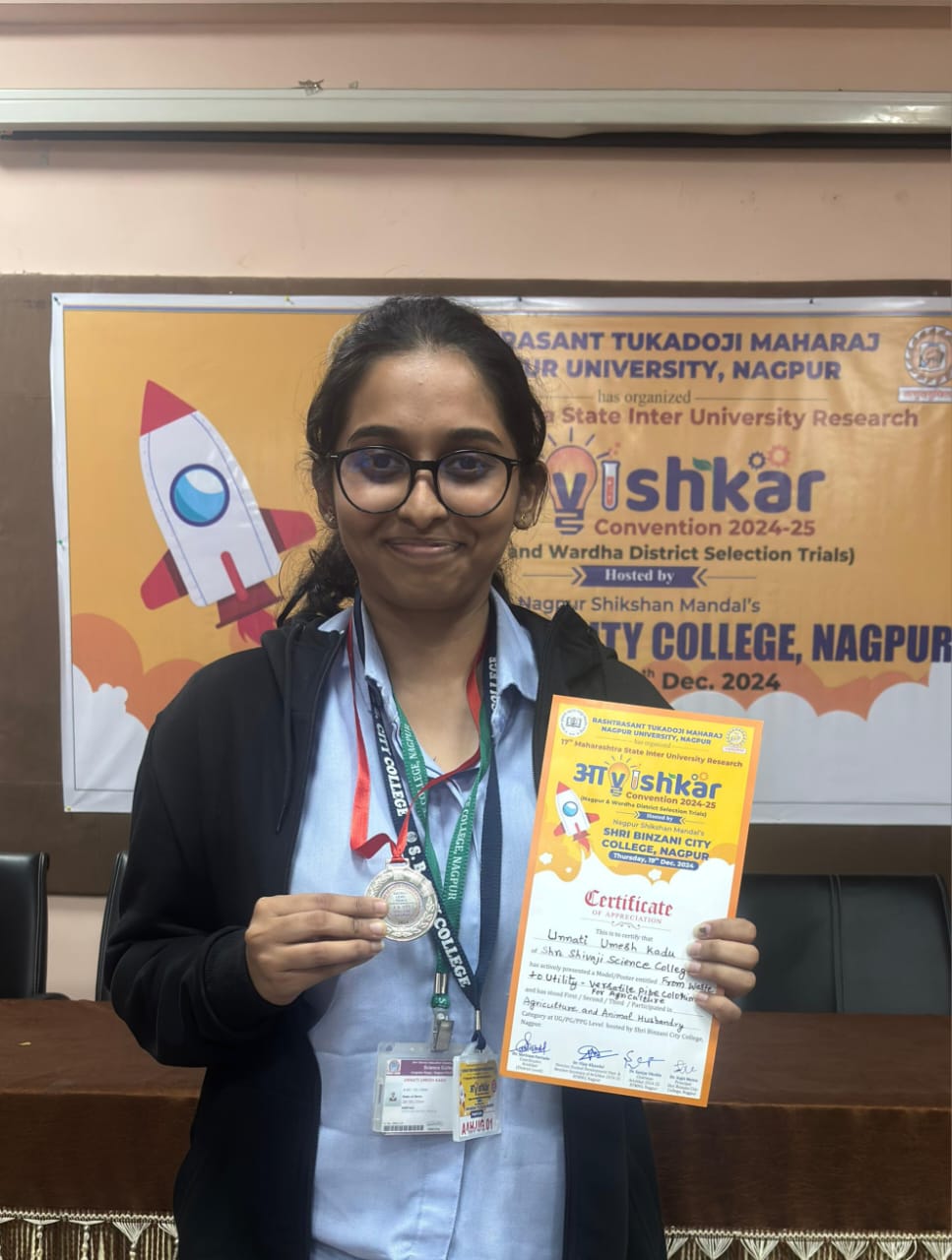
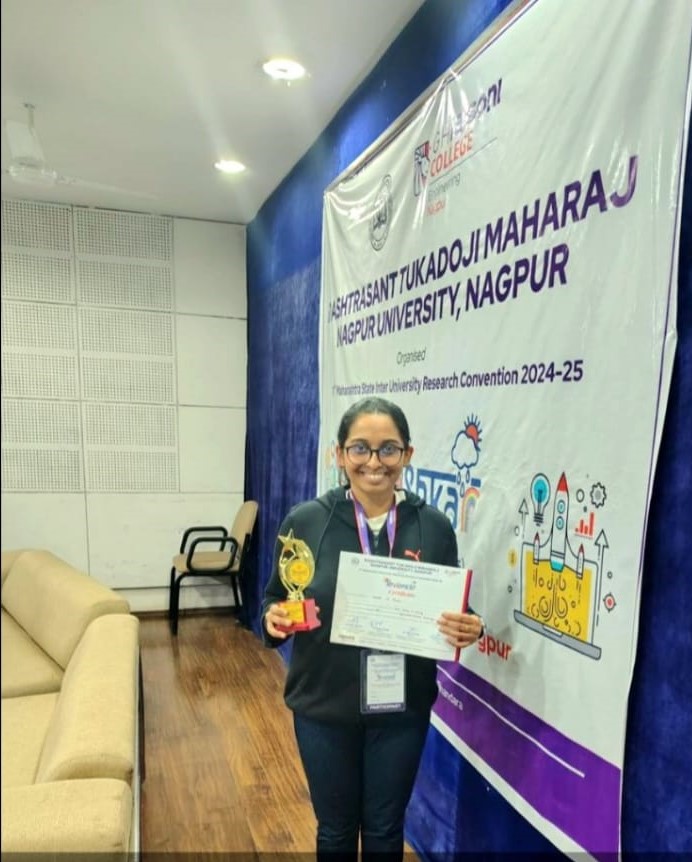
Ms. Unnati Kadu
2) Pedago Spectra Flame Photometer
At the Science Expo and Innovation Festival held from 16th to 19th January 2025 at the Raman Science Centre & Planetarium, Nagpur, a notable working model titled “Pedago Spectra Flame Photometer” was presented by Ms. Isha Jogani and Ms. Kumudini Bawane under the guidance of Dr. Sarang Dhote from Science College, Congress Nagar, Nagpur. The model showcased the principle of flame photometry, a technique used to detect metal ions like sodium, potassium, and calcium through the colors they emit in a flame. Aimed at creating a low-cost, portable flame photometer, the project emphasized its relevance in environmental, agricultural, clinical, and educational applications. Commercial flame photometers are often expensive, but this model—costing under ?3500—offers an accessible alternative for educational institutions. It includes a simple flame source, metal sample holder, and an optical detection unit built from low-cost, recyclable materials, ensuring sustainability. The system integrates a smartphone application to capture and process light intensity, enabling real-time calculation of metal ion concentrations and enhancing digital learning experiences. Designed to be student-assembled, the device encourages hands-on learning and simplifies complex analytical chemistry concepts. Its clear demonstration drew significant attention at the expo, earning appreciation and awards from the Director of Raman Science Centre. The project bridges theoretical knowledge with practical skills, allowing learners to observe and quantify emission spectra, and highlights resourcefulness in scientific design. Beyond education, the compact photometer holds potential for preliminary testing in remote areas and basic research laboratories, making it a transformative, affordable, and impactful tool in science education.
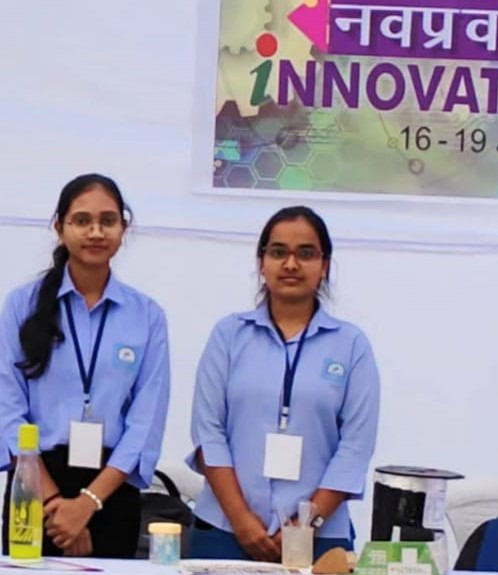
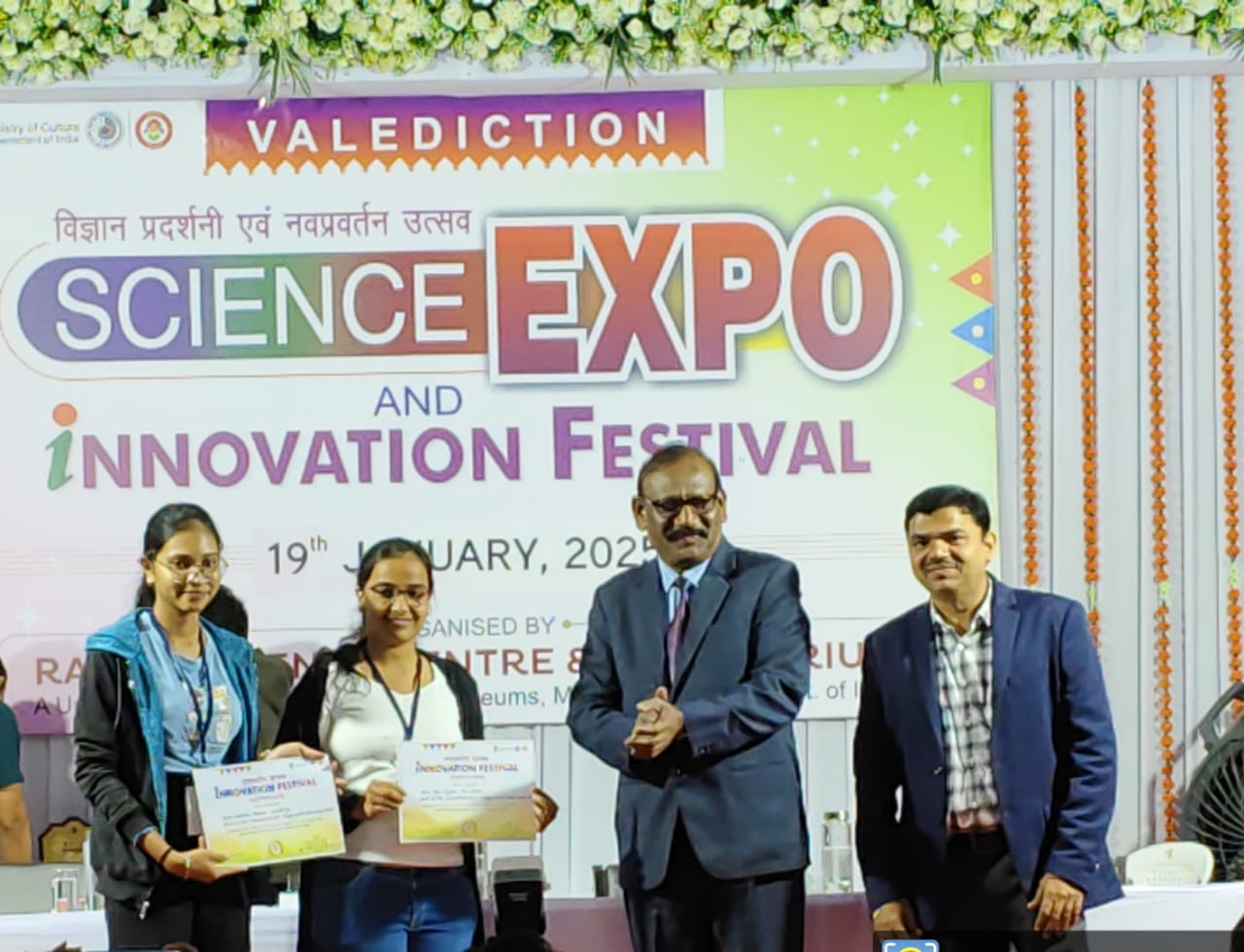
Ms. Isha Jogani and Ms. Kumudini Bawane
3) From Waste to Utility: Versatile Pipe Colorimeter for Agriculture, Health, and Environment
Ms. Isha Jogani from the Department of Microbiology, Science College, Nagpur, participated in Round 1 of the 17th Avishkar Research Convention 2024–25, held at Binzani City College, Nagpur, under the Humanities, Language and Fine Arts category. She received a Certificate of Participation for her innovative project titled "Revolutionizing Education with DIY Pipe-Based Colorimeter." Her project introduces a low-cost, do-it-yourself colorimeter constructed using simple PVC pipes and basic electronic components, aimed at making scientific tools more accessible to students in rural and underfunded schools. This eco-friendly device, developed using waste electric pipes, supports hands-on learning and fosters scientific curiosity among students by enabling basic colorimetric analyses for educational experiments. The model simplifies the understanding of the Beer-Lambert Law, a fundamental concept in spectroscopy, making science more approachable for young learners. Traditional colorimeters are often expensive and inaccessible; Ms. Jogani’s innovation bridges this gap by transforming waste into a functional, affordable educational tool. Designed with simplicity and user-friendliness in mind, it empowers students to grasp key concepts of light absorbance and transmittance through practical engagement. The project not only enhances science education in resource-constrained settings but also supports environmental sustainability by repurposing materials that would otherwise go to waste. It aligns with green initiatives and encourages eco-consciousness among young scientists. Additionally, this model inspires creativity and resourcefulness in laboratory practices, promoting a culture of innovation and sustainability. Its affordability, versatility, and educational impact make it a valuable tool for schools, colleges, and educators striving for cost-effective scientific outreach.
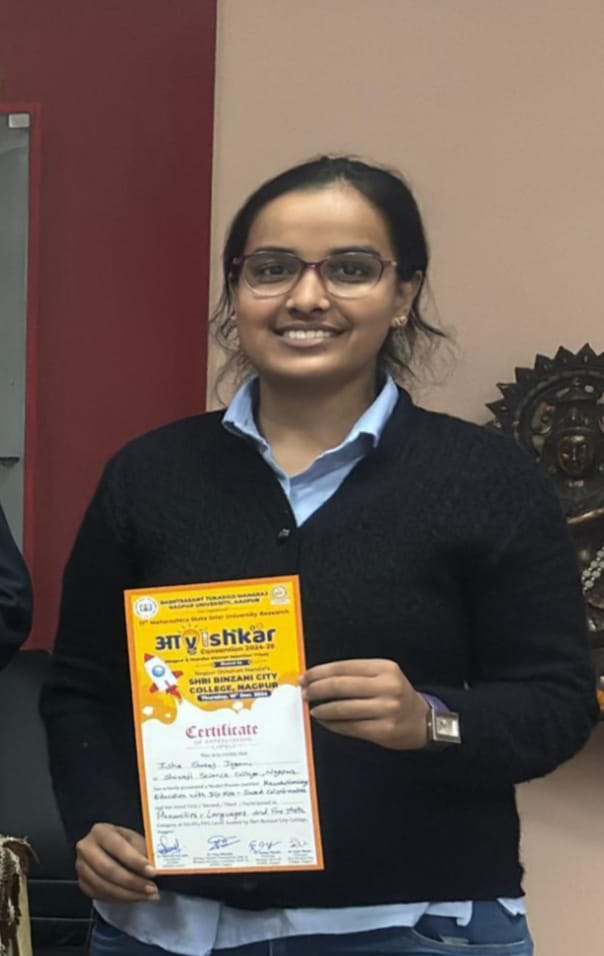
Ms. Isha Jogani
4) Biobattery
Ms. Arya Walode and Ms. Akanksha Bisen, M.Sc First Year Microbiology students, have created a groundbreaking biobattery that converts glucose into electrical energy. This biobattery utilizes the breakdown of glucose by enzymes, which releases electrons and protons to generate power. Escherichia coli is employed for its efficient glucose metabolism, optimizing the battery’s electricity production. Unlike conventional batteries, these biobatteries offer a cleaner alternative by avoiding corrosive substances like hydrochloric or sulfuric acid. Additionally, they have potential medical applications, such as powering devices within the human body, due to the glucose present in blood. With the guidance and support of their teachers, ongoing research aims to refine these batteries and explore their broader applications in both technology and healthcare. As the technology advances, biobatteries could play a significant role in sustainable energy solutions and innovative medical devices.
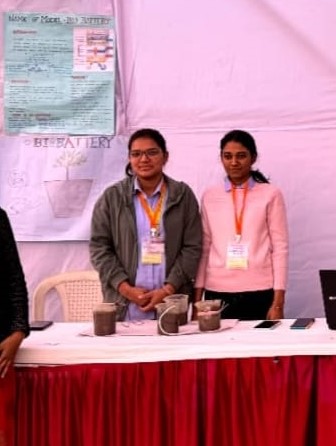
Ms. Arya Walode and Ms. Akanksha Bisen
5) Central dogma of life
Ms. Ojaswini Bhagat and Ms. Vaishnavi Ingle, M.Sc First Year Microbiology students, along with Ms. Bhumika Mirashi from the B.Sc Final Year, have delved into the central dogma of molecular biology, a fundamental framework illustrating the flow of genetic information within cells. This concept encompasses DNA replication, transcription, and translation: DNA is replicated to generate more DNA, transcribed into mRNA, and then translated into proteins. This sequence is crucial for understanding how genetic information is transferred and expressed within organisms. Biopolymers, including proteins, RNA, and DNA, play essential roles in this process. Standard biological information flow includes DNA replication (DNA copied to DNA), transcription (DNA information transcribed to mRNA), and translation (mRNA used as a template for protein synthesis). Special processes involve RNA replication (RNA copied from RNA) and reverse transcription (DNA synthesized from an RNA template). Some unknown processes, such as direct protein synthesis from DNA without mRNA or the use of protein structures as templates for RNA or DNA synthesis, remain subjects of active research.
In their experiments, Ms. Bhagat, Ms. Ingle, and Ms. Mirashi are exploring these fundamental mechanisms to deepen their understanding of genetic information manipulation and expression. Their research aims to push the boundaries of the central dogma, potentially uncovering novel mechanisms and advancing applications in genetic research and biotechnology.
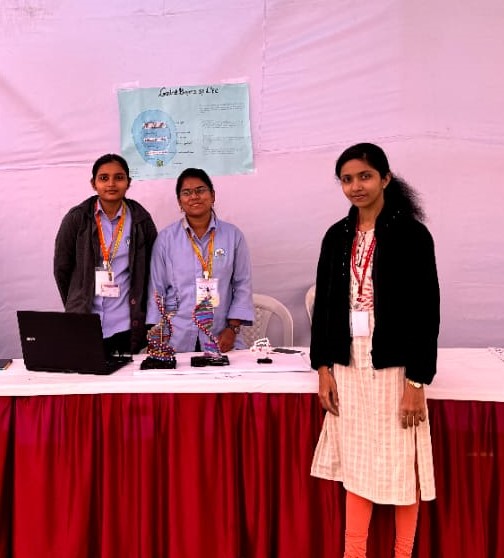
Ms. Ojaswini Bhagat and Ms. Vaishnavi Ingle (M.Sc First year)
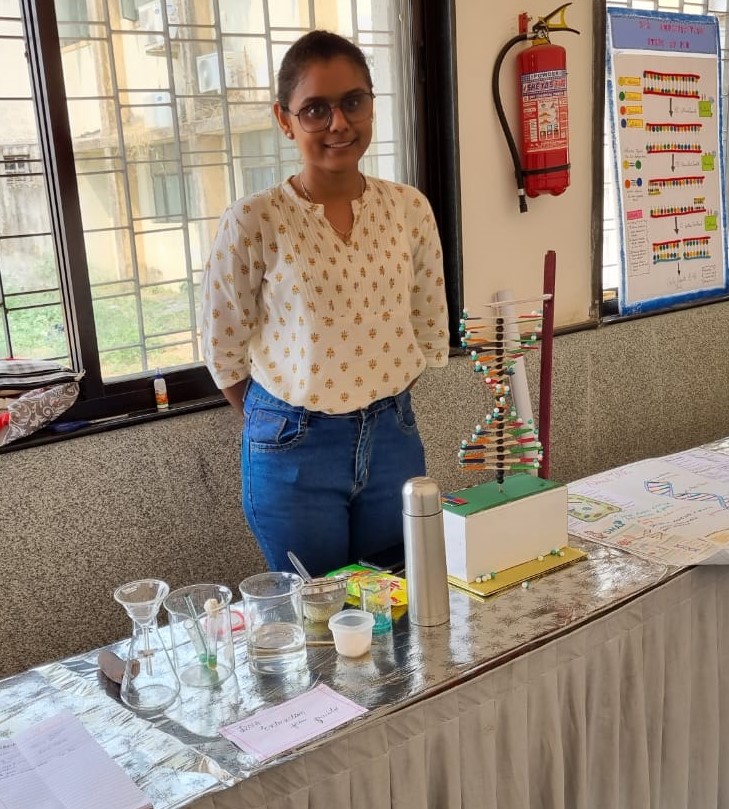
Ms. Bhumika Mirashi (B.Sc Final year)
6) AquasafeGuard: On-Field Microbial Assessment for Rapid Detection of Water Contamination
Ms. Ishita Padgil, M.Sc First Year Microbiology, in collaboration with postgraduate Microbiology teachers, has developed an innovative experiment titled "AquasafeGuard: Rapid On-Field Microbial Assessment for Water Contamination Detection." This pioneering project aims to create a cutting-edge system designed for the swift and precise detection of microbial contamination in water sources. AquasafeGuard is engineered to operate effectively in field settings, offering a practical solution for real-time water quality assessment. The system integrates advanced microbial detection methods with user-friendly tools, facilitating the rapid identification of harmful microorganisms and evaluating the overall potability of water samples. Unlike traditional laboratory-based methods, which often involve lengthy turnaround times and may be inaccessible in remote or resource-limited areas, AquasafeGuard provides immediate results on-site.
This project addresses the urgent need for reliable and timely water safety assessments, which are crucial for preventing waterborne diseases and safeguarding public health. By emphasizing ease of use and speed, AquasafeGuard empowers individuals and communities to make informed decisions about their water sources. Its implementation has the potential to significantly enhance public health surveillance, bolster emergency response efforts, and improve overall water quality management. Given the global challenges posed by water contamination, AquasafeGuard represents a vital advancement in ensuring safe and clean drinking water. The development of this technology highlights Ms. Padgil's dedication to advancing practical solutions for critical environmental and health issues.
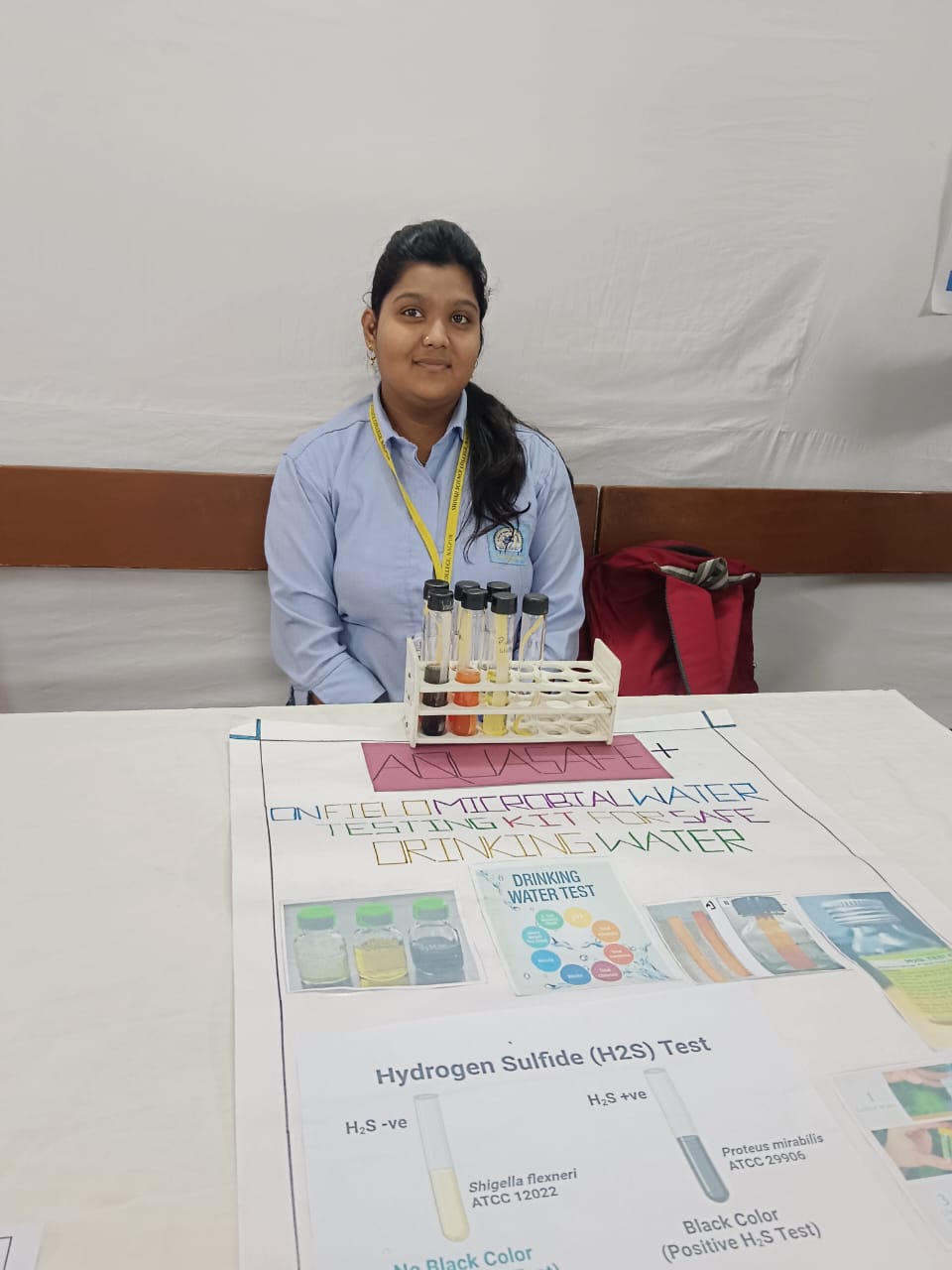
Ms. Ishita Padgil
7) Herbal Antiseptic Soap preparation
On February 28, 2023, during the Science Day celebrations at RTM Nagpur University, Bhumika Mirashi, a final-year B.Sc. student from the CMBT group, presented her project titled "Herbal Antiseptic Soap Preparation." Guided by her teachers, Bhumika’s project focused on creating a soap enriched with natural antiseptic properties. The formulation utilized essential oils and extracts from herbs such as neem, tea tree, and aloe vera, known for their antimicrobial and skin-soothing benefits.
Her presentation detailed the selection and preparation of these herbal ingredients, the soap-making techniques employed, and the testing of the final product for its antiseptic effectiveness. Bhumika emphasized the growing consumer demand for natural and eco-friendly personal care products, highlighting the advantages of herbal soaps over synthetic alternatives. Her project not only showcased her technical skills in product development but also underscored her understanding of the broader trends towards sustainable and health-conscious hygiene solutions. The presentation was well-received, reflecting both the practical application of her work and its relevance to current industry trends.
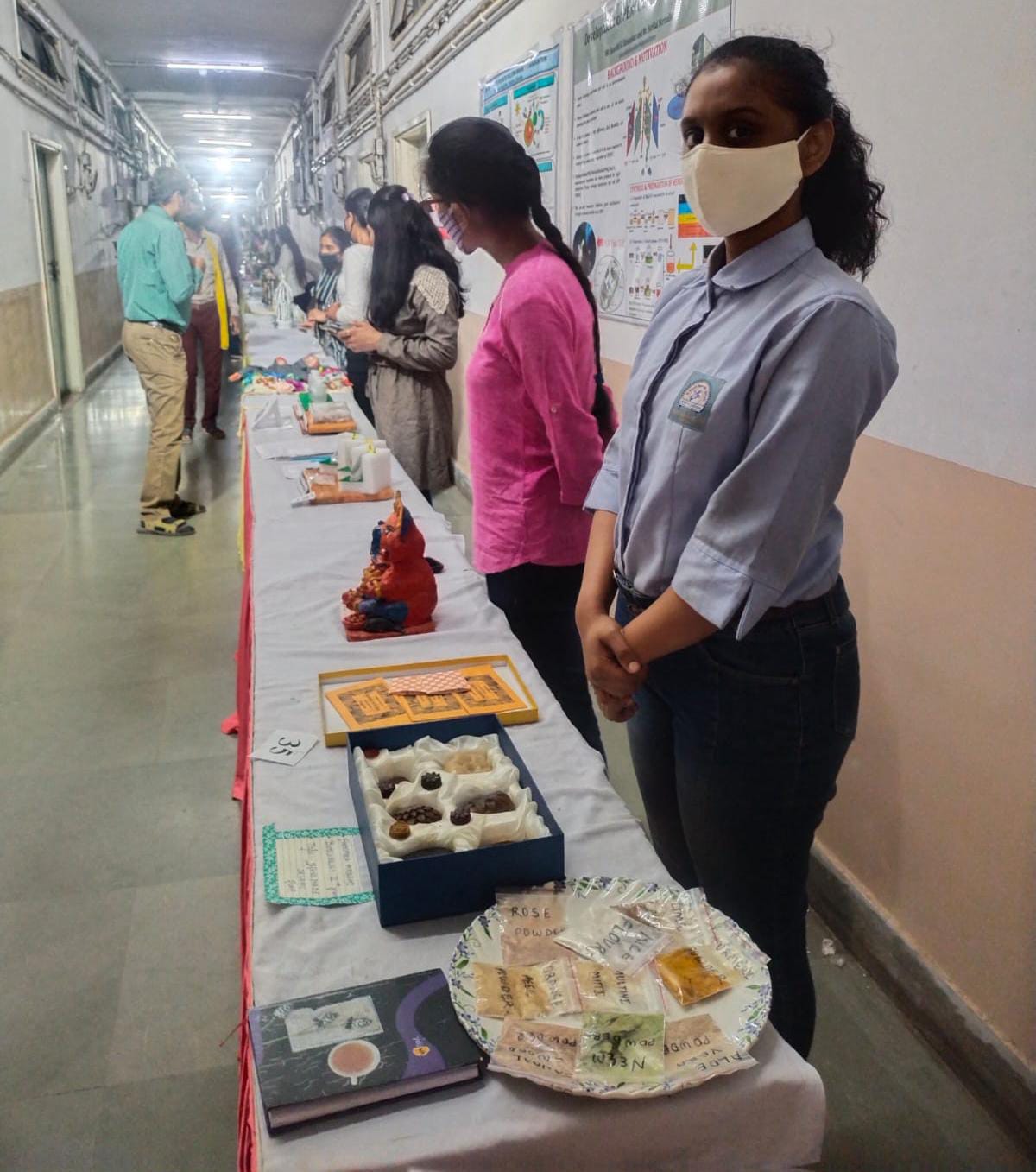
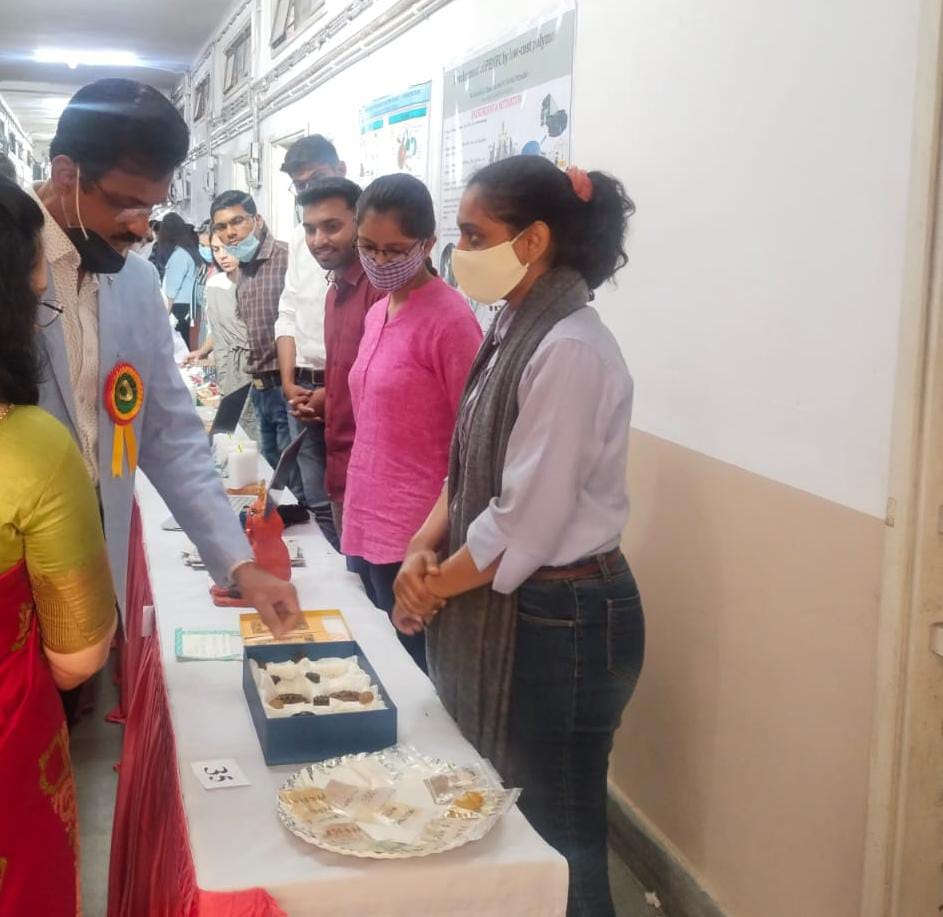
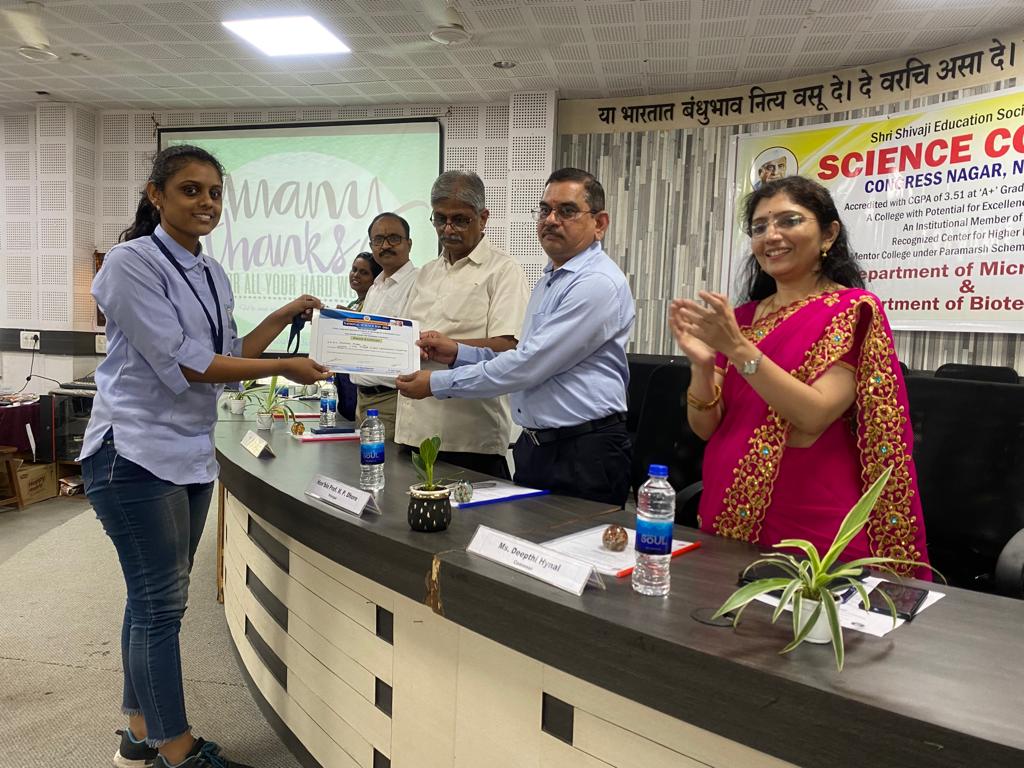
Ms. Bhumika Mirashi
8) Fluid Mosaic Model
Ms. Janhavi Zade and Tanuja Sable, first-year M.Sc. Microbiology students, have made significant strides in advancing our understanding of the Fluid Mosaic Model of cell membranes. Under expert guidance, their project offers a detailed examination of the lipid bilayer and membrane proteins, highlighting their dynamic interactions and roles. Utilizing advanced visualization techniques, they have produced novel insights into the fluidity and flexibility of membranes. Their rigorous experimental validation and creative problem-solving not only enhance the traditional Fluid Mosaic Model but also contribute valuable new perspectives to the field. Their work includes exploring how variations in lipid types and concentrations affect membrane properties, providing a more nuanced understanding of membrane functionality. Additionally, their project addresses how these findings can be applied to real-world biological scenarios, such as drug delivery and membrane-based diagnostics. Their research exemplifies their commitment to scientific excellence and innovation, reflecting their dedication and technical skill in microbiology. This comprehensive approach demonstrates their ability to push the boundaries of current scientific understanding and make meaningful contributions to the discipline.
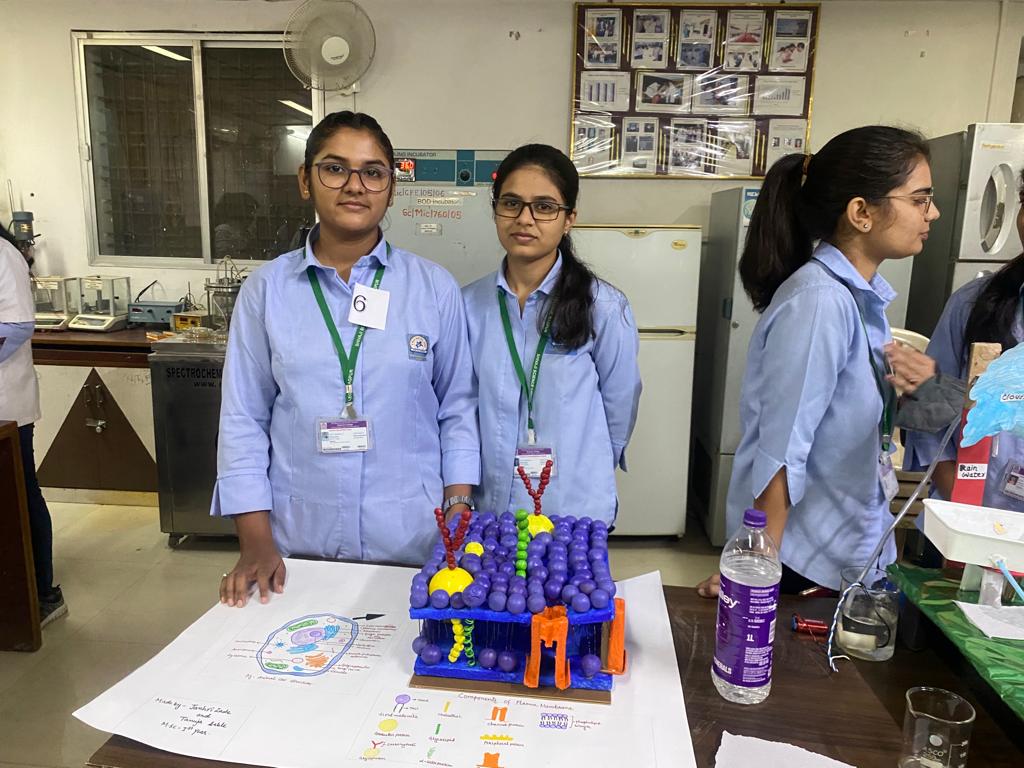 Ms. Janhavi Zade and Ms. Tanuja Sable
Ms. Janhavi Zade and Ms. Tanuja Sable
9) Biofertilizer from Egg shells
Ms. Sayami Patriker and Ms. Snehal Choudhary, first-year M.Sc. Microbiology students, have undertaken an innovative project on producing biofertilizers from eggshells. Their research aims to transform eggshell waste—a common byproduct in the food industry—into a sustainable and eco-friendly fertilizer. Rich in calcium carbonate, eggshells are processed through cleaning, drying, and grinding, and then subjected to microbial fermentation to enhance their nutrient availability and bioactivity. By culturing specific beneficial microorganisms, they break down the calcium carbonate into forms that plants can easily absorb. Their project includes thorough testing to evaluate the effectiveness of this eggshell-derived biofertilizer on plant growth, nutrient uptake, and soil quality compared to conventional fertilizers. They also assess the environmental benefits, such as waste reduction and lower ecological impact compared to synthetic fertilizers. Sayami and Snehal’s work not only addresses waste management but also promotes sustainable agricultural practices, showcasing their commitment to environmental sustainability and practical microbiological solutions.
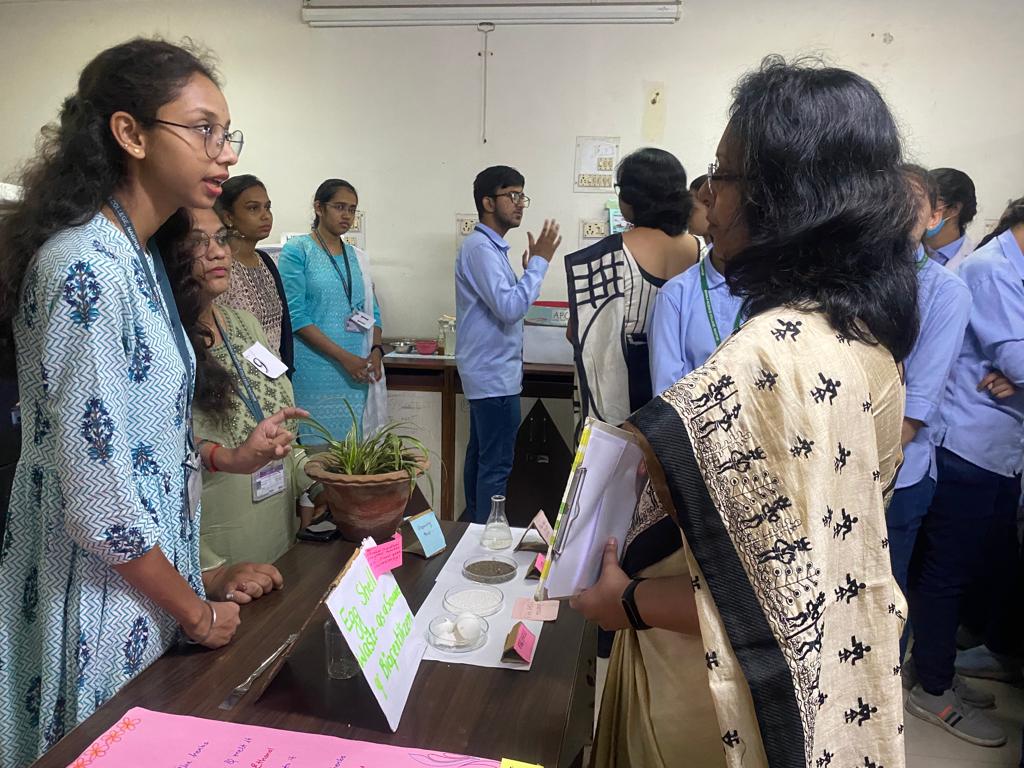 Ms. Sayami Patriker and Ms. Snehal Chodhary
Ms. Sayami Patriker and Ms. Snehal Chodhary
10) Drip Irrigation system
Ms. Aishwarya Mohatkar and Ms. Neha Mahant, first-year M.Sc. students, have created an impressive project titled "Drip Irrigation System Working Model." Their work focuses on constructing a functional model that illustrates the principles of drip irrigation, a highly efficient technique for delivering water directly to plant roots. This method significantly reduces water waste and ensures that plants receive adequate moisture. Their model includes essential components such as a network of tubing, emitters, and a water reservoir, all carefully assembled to demonstrate the precise delivery of water to plants. The system features adjustable flow rates, allowing users to tailor the irrigation to various plant needs and soil conditions.
The project also involves evaluating the model’s efficiency compared to traditional irrigation methods. Through extensive testing, Aishwarya and Neha have assessed how well the system conserves water and supports plant growth. Their model highlights the advantages of drip irrigation, including its ability to enhance agricultural productivity while conserving water resources. Aishwarya and Neha’s project emphasizes the importance of sustainable farming practices and innovative water management. Their practical demonstration of drip irrigation technology not only provides a valuable educational tool but also contributes to the goal of improving resource efficiency in agriculture. Their work showcases their dedication to addressing contemporary agricultural challenges with effective and practical solutions.
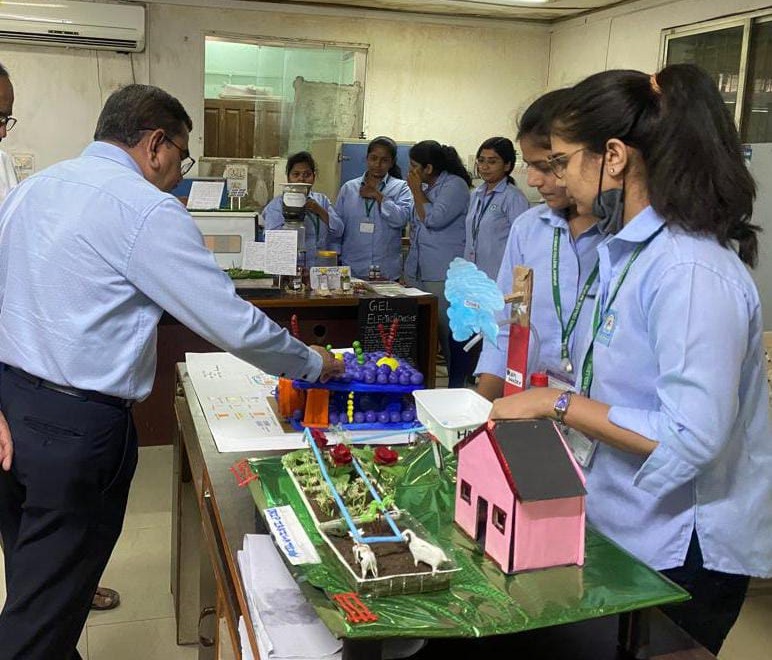 Ms. Aishwarya Mohatkar and Ms. Neha Mahant
Ms. Aishwarya Mohatkar and Ms. Neha Mahant
These projects highlight how the Department of Microbiology not only fosters students' talents but also underscores its commitment to creating a dynamic and innovative environment. The department provides a robust platform for students to showcase their experimental skills, innovative ideas, and dedication. Additionally, it encourages a collaborative atmosphere where students can engage with cutting-edge research and gain practical experience, further enhancing their academic and professional growth.